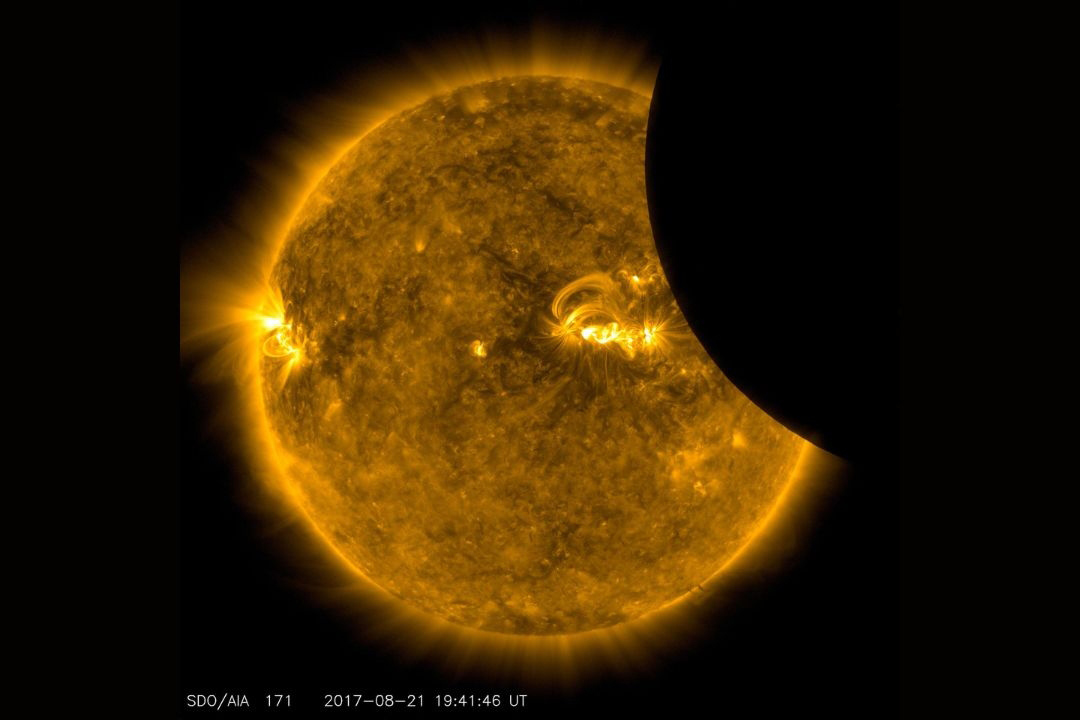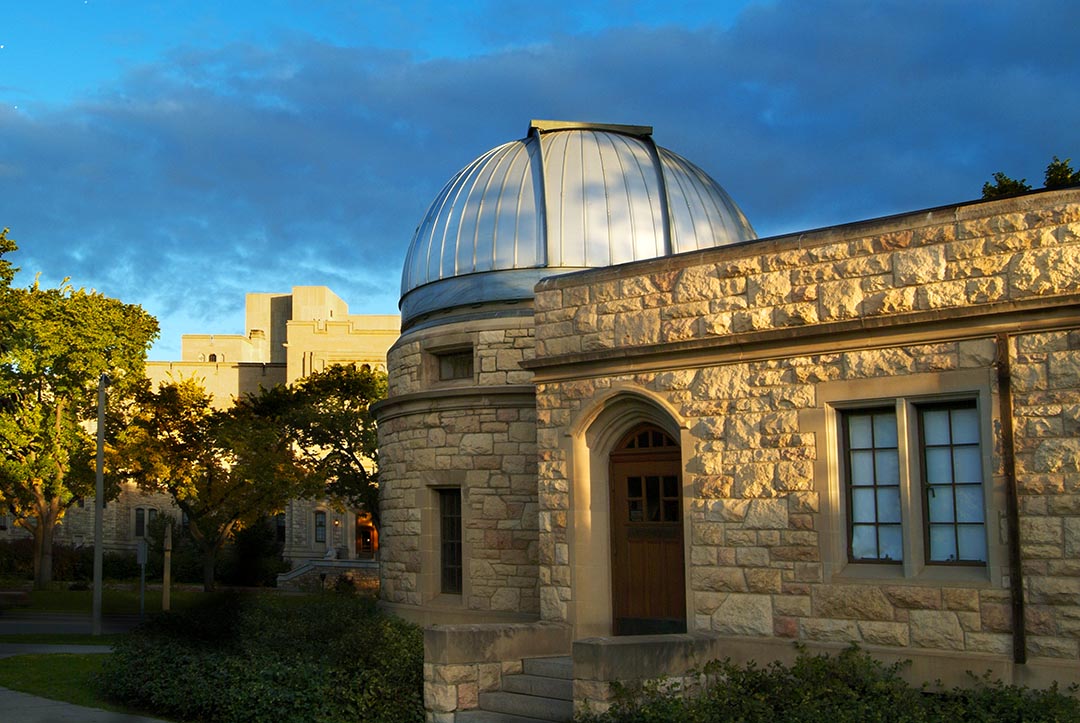
Five things to know about the upcoming solar eclipse: USask space expert
A solar eclipse is going to cross skies across Canada on April 8, and University of Saskatchewan (USask) space experts weigh in on some interesting facts about how a solar eclipse works – and what you’ll be able to see right here in Saskatchewan from the USask Observatory at their special event.
By BROOKE KLEIBOERDr. Carley Martin (PhD) is a programmer at the Super Dual Auroral Radar Network (SuperDARN) Canada, an international collaboration and a global network of scientific radars that monitor conditions in the near-Earth space environment. With a doctoral degree in planetary physics and a master’s degree in astrophysics, and as a staff member of the USask College of Arts and Science Institute of Space and Atmospheric Studies, Martin is passionate about all things space and planetary physics, and said this will be her fourth solar eclipse viewing in-person.
She shared her expertise to shed some light on interesting facts about solar eclipses, and what to know about the upcoming stellar event.
Why and how do solar eclipses happen?
“A solar eclipse occurs when the moon passes between the sun and Earth,” Martin said. “The moon covers all or part of the sun from the Earth’s perspective, and we see a dimming of the sun during partial eclipses. During total eclipses it can appear as nighttime or dawn/dusk for a few moments.”
On April 8, Saskatchewan will experience a partial solar eclipse, but according to the Canadian Space Agency, those located in some areas of Ontario, Quebec, New Brunswick, Nova Scotia, Prince Edward Island, and Newfoundland will experience a total solar eclipse for a few minutes.
“Total eclipses are actually a very rare phenomena in general,” she said. “We just so happen to live on a planet that has a moon that appears around the same size as our star in the sky. We’re very fortunate to be able to experience eclipses at all!”
What makes the 2024 total solar eclipse particularly significant?
Martin said the 2024 solar eclipse is unique in a couple of ways: it very closely follows the last solar eclipse that took place in 2017, and will last a particularly long time for viewers to safely enjoy.
“Normally, the same location on Earth may see a total eclipse every 300-400 years,” she said. “The fact that North America has seen two total eclipses within seven years is very special.”
The sun will be blocked by the moon at totality for almost four and a half minutes, Martin shares, which is almost double the length of totality in 2017. Saskatchewan locations won’t experience totality, but anyone watching the sky may notice a change in the level of light coming from the sun if they are outside during peak solar activity.
“Here in Saskatchewan, we will likely see only up to 45 per cent coverage of the sun, which may just be enough to sense that the sun is slightly dimmer than usual without looking through one of our telescopes on the day,” Martin said. “We will be able to see some of the sun covered by the moon in Saskatoon from 11:53 am to 1:52 pm where the maximum coverage of approximately 45 per cent is at 12:52 pm.”
There has been lots of buzz about how the sun is near its solar maximum, and will make this eclipse especially interesting to see. What is a solar maximum, and how does this affect what we may see during the eclipse?
The sun has a cycle of activity that lasts around 11 years, Martin said. The appearance of sunspots – areas of the sun that seem dimmer than other areas – help scientists to gauge levels of solar activity.
“The cycle starts off at a ‘minimum’, where we see a reduced number of sunspots,” Martin explained. “Activity then ramps up to a peak around five and a half years later, which we call the ‘maximum’ of the cycle, where we see lots of sunspots, solar flares and coronal mass ejections, which are expulsions of particles from the solar atmosphere that create the sun’s corona.”
Martin said our most recent solar cycle began in December 2019, “meaning we are entering the time of high activity we call ‘solar maximum’ where the peak of activity is expected in summer 2025.”
For space physicists, a solar eclipse when the sun is near its solar maximum is very exciting to observe as they can apply their observations of increased solar activity during the eclipse to their understandings of the solar cycle and day-to-night cycles.
“At SuperDARN Canada, we study the upper atmosphere of Earth using radars, which can fluctuate in composition and density during day and nighttime, and solar cycle,” Martin said. “Being able to study the effects of this short-term ‘nighttime’ in the middle of the day during solar maximum is very exciting and can give us more insight into the processes that are occurring there.”
How does the moon’s current position affect an eclipse and its length?
The moon passing in front of the sun is what creates a solar eclipse, so where the moon is located compared to Earth makes a difference to what people on Earth can see in a solar eclipse. Solar eclipses actually happen annually, but they are not always visible due to the position of the moon.
“The moon is not always in the right position to completely cover the sun, and we see partial and ‘ring-of-fire’ eclipses too,” Martin said. “We know a new moon (where the moon’s surface is not illuminated by the sun and the sun is on the other side) happens once every 29.5 days or so, so why don’t we get an eclipse every 29.5 days?”
This phenomenon is due to how the moon is tilted. The moon is tilted and orbits five degrees above and below the ecliptic plane – the imaginary line from the Earth to the sun. If this plane is intersected, it will block the sun’s rays to the Earth.
“We only see eclipses when the moon crosses the ecliptic plane at a new moon – which makes them a little rarer,” she said. “The moon also has an elliptical orbit, where it moves slightly towards and away from the Earth along its orbit. This is why we often see annular eclipses that do not fully cover the sun. The reason why the 2024 total eclipse will last longer than the 2017 totality is because the moon is slightly closer to Earth on its orbit, and so appears slightly larger in the sky and hence spends more time in front of the sun.”
In fact, solar eclipses that people can see from Earth will one day disappear completely.
“The moon is slowly drifting away from the Earth at around 3-4 cm per year due to gravitational effects,” Martin explained. “That is extremely slow, and it means that in about half a billion years the moon will be too far from Earth to cover the sun fully, and humanity on Earth will no longer see total solar eclipses.”
Why is it important to view an eclipse safely (whether it is total or partial)?
Viewing any solar event safely is very important. Although the sun can appear to be darker, the strength of its radiation is not and can cause injury to human eyes at any time, even when the overall light level appears to be dimmer.
“The sun is a big ball of plasma radiating heat and light in all directions,” Martin said. “Just like in the summer where you need to protect your skin from burning in the sun, you also need to protect your sensitive eyes too.”
Although there is a time period when a solar eclipse reaches totality where eclipse viewers can safely remove eye protection, Saskatchewan will not experience totality and thus there is no safe time to view the April 8 eclipse without proper eye protection and equipment.

Solar eclipse viewing event at USask Observatory
The USask Observatory is hosting a free public event on Monday, April 8 when everyone is invited to come safely view the partial solar eclipse and learn from space experts. Look safely at the sun through the observatory’s special solar telescope and RASC telescopes with solar filters.
Visitors to the USask Observatory will get a sneak peek at a special solar telescope on the day of the eclipse when increased solar surface activity will be viewed in real time using special filters. This telescope will be used to monitor the activity on the solar surface regularly.
Presented by the USask Observatory, the Royal Astronomical Society of Canada (Saskatoon Centre) and SuperDARN Canada, you will have the opportunity to tour the observatory facilities and view equipment, learn to make pinhole cameras that allow you to safely view the solar eclipse, and hear from SuperDARN space experts about sun and space physics. Find more information about the event here.
Together, we will undertake the research the world needs. We invite you to join by supporting critical research at USask.

